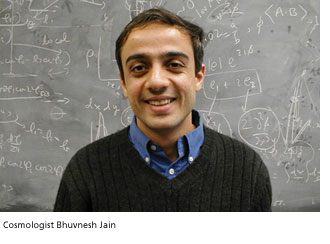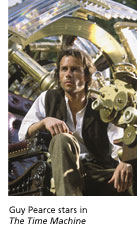
From Time to Time
The Science of Going from Now to Then

The movie DreamWorks put together, based on the H.G. Wells classic The
Time Machine, spends about half its time in Victorian-era Manhattan
and the rest of the time in the same place, only 800,000 years in the
future. "I’m from here, just not from now," the time traveler
tells a flirty New Yorker of 2030 during a brief stopover.
Director Simon Wells, the great grandson of the visionary sci-fi author, takes a lot of trouble to convince the viewer that Alexander Hartdegen, a professor of applied mechanics and engineering at Columbia, has put more science than fiction into his time machine. The suitably distracted inventor exchanges letters with a "crackpot" patent clerk named Albert Einstein. "He deserves all the help I can give him," blurts Hartdegen. Two stories of chalkboards in his study are crammed with inscrutable symbols and formulae, which work out the "science" that makes his machine go.
Class
Time
"Time travel is tricky business," concedes Bhuvnesh Jain, an
assistant professor in the department of physics and astronomy. The soft-spoken
cosmologist studies gravitational lensing, an effect predicted by Einstein
in which light bends around giant, unlit structures in the heavens, distorting
or "lensing" an illuminated source behind it. Measuring the
effect helps researchers determine how much "dark matter" is
out there and thus to predict the future of the universe.
The Time Machine spends little time on the principles of physics behind Hartdegan’s gleaming gizmo. Instead, he releases the handbrake and throttles up the part quaint-Victorian contraption of turning gears and polished brass, and part futuristic, laser-powered sphere that bears him along while cities and landscapes sprout and recede around his bubble of time present.
"Whether time travel is possible or not is in some ways an open question," Jain observes. "A small but reputable group of relativists have recently re-examined the possibility within Einstein’s relativity theory."
 Travel
into the future—or at least the slowing down of clocks—has already
been experimentally established. Jump into a rocket, step on the gas,
and time for the space traveler slows down, which is to say that outside
the ship time moves faster. The universal now, Einstein showed,
is an illusion. "The astronauts who have gone into space and circled
the earth have experienced this effect," Jain explains, "but
it’s very, very tiny. It’s a fraction of a second, unless you
get extremely powerful rockets that can accelerate to a good part of the
speed of light." Theoretically, an astronaut could journey into space
and over the course of the voyager’s life, return to earth from time
to time monitoring the rise and fall of empires.
Travel
into the future—or at least the slowing down of clocks—has already
been experimentally established. Jump into a rocket, step on the gas,
and time for the space traveler slows down, which is to say that outside
the ship time moves faster. The universal now, Einstein showed,
is an illusion. "The astronauts who have gone into space and circled
the earth have experienced this effect," Jain explains, "but
it’s very, very tiny. It’s a fraction of a second, unless you
get extremely powerful rockets that can accelerate to a good part of the
speed of light." Theoretically, an astronaut could journey into space
and over the course of the voyager’s life, return to earth from time
to time monitoring the rise and fall of empires.
 Although
it’s accepted that rocketing into the oncoming future is possible,
many scientists believe you can’t go home again, even though there’s
nothing in relativity theory that seems to forbid travel into the past.
The prohibition comes from the paradoxes yielded by reversing the arrow
of time, such as a visitor to the past going back before his birth and
murdering his mother. How did he come to travel into the past, if he never
existed? "That’s a severe paradox," Jain contends, "and
it’s not clear how it would be circumvented by a scenario in which
travel back in time is allowed."
Although
it’s accepted that rocketing into the oncoming future is possible,
many scientists believe you can’t go home again, even though there’s
nothing in relativity theory that seems to forbid travel into the past.
The prohibition comes from the paradoxes yielded by reversing the arrow
of time, such as a visitor to the past going back before his birth and
murdering his mother. How did he come to travel into the past, if he never
existed? "That’s a severe paradox," Jain contends, "and
it’s not clear how it would be circumvented by a scenario in which
travel back in time is allowed."
Some theorists postulate that relativity allows for passageways through holes in the flexible fabric of space-time. Called wormholes, the portals fold together vastly separate regions of the universe, connecting them with a shortcut tunnel that could also lead to past or future points in time.
"It requires pushing relativity to extremes," Jain says of the cosmic hole-punch origami. The engineering feat to create and keep open a wormhole would take a technology well beyond our current capabilities, he argues. "It requires a concentration of energy that’s trillions and trillions of times greater than what our most powerful particle accelerators are capable of. What kind of technology could conceivably allow us to take even the first step? It’s not even something one can speculate on."
Lunch
Time
Jain calls the time machine "a nifty-looking device," but considers
the movie’s Star Wars appliance no more than a visual treat
from the special-effects wizards at DreamWorks.
"Bet that makes a hell of a cappuccino," quipped the New Yorker of the near future when she caught sight of the conveyance that hurtled the time traveler across the ages.
But it doesn’t even do that, unless you count the brutish Morlocks of the far future, who spend the latter part of the film trying to gulp down the Victorian cocktail the machine served up.